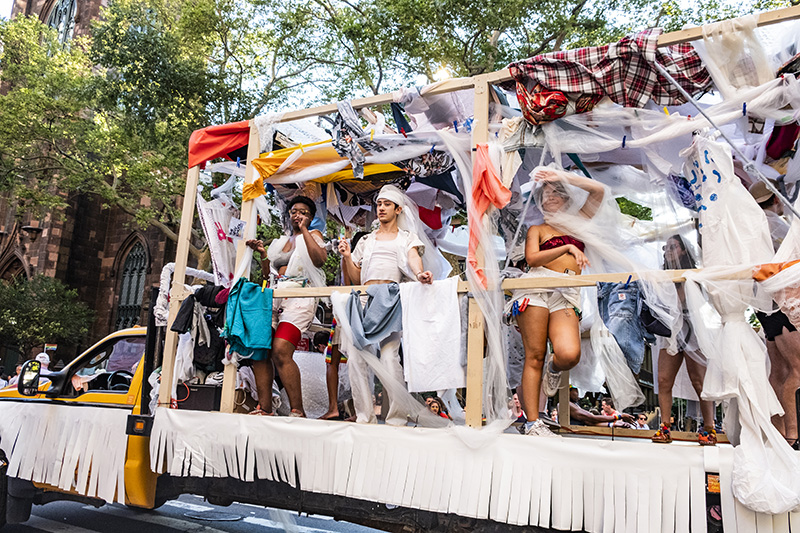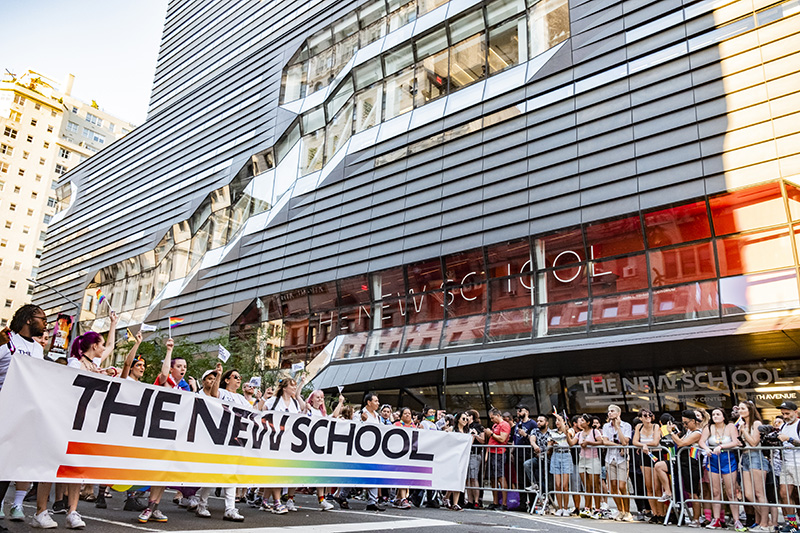
Parsons Students Create Float for the 2019 New York City Pride March that is the First in University History
For the first time in its history, Parsons School of Design students created a float for the June 30 NYC Pride March that is quite different from what spectators and viewers saw elsewhere during the parade.
The float was designed by a Parsons class called “Queering Space” and they were eager to facilitate the “transformation of normative space through performance” according to Liam Pitts, one of the Parsons students who designed the float and participated in the march.
“A queer space is genuine, emotional and ephemeral,” says Pitts, BFA Product Design ’19. “Our float is a performance of the queer spaces in our past that have shaped our individual identities. As queer people, all of our stories transcend time and space to help us navigate the new worlds we create and subvert those that seek to disregard us and diminish our voices.”
William Fryer, MFA Interior Design, ’17, and Lena Kouvela, MFA Interior Design ’17, the class instructors, say that the float was created to “disrupt” an event that has become complicit in “reinforcing typical normative structures.” Both Fryer and Kouvela are Parsons graduates and design professionals.
During the parade, students and New School volunteers were part of a theatrical performance that through music, dance, movement and design, told intimate stories about experiences that shaped their lives as queer individuals. At intervals, the group performed stories recorded by students which offered glimpses into their queer identities. Each story was performed using its own specific material, usually a fabric. The group manipulated the material as one entity to illustrate a spatial aspect of the story being told. Through performance, the individual experience became a shared one. As each story concluded, its material was hung back on the frame of the float, like laundry drying in the sun.

The float consisted of a simple, timber frame, outfitted with hooks and clips, upon which a group of performers collaged a variety of soft materials. This expresses certain qualities inherent to queer space: it is ephemeral, gestural, and improvised. During the march, space appeared and disappeared demonstrating the feelings and expressive urges of the group. The float was not created as a static installation but something more fleeting that can be broken apart and put back together again.
Pitts says that the fabric and clothes on the float represented the students, “vulnerable to the elements but together creating one new space from many others.”
The students in the class come from a variety of backgrounds, including fine arts, photography, textiles, product design, and urban strategy.
“This class gave them the opportunity to express themselves as queer people in their own disciplines in whatever way they desired,” says Fryer.
More than a hundred New School students, staff, and faculty also marched in the parade, wearing New School pride t-shirts. The group displayed a rainbow branded banner and kept time to a performance from a university Maracatu band.
“This was actually my first pride but I don’t think being in the parade meant as much when compared to the feeling of being surrounded by people and not worrying about having my guard up,” said Pitts. “The Pride March offered an escape where we weren’t limited by our pasts but instead empowered to draw from them to create a more queer space.”
“Our float evolved from our individual personal stories,” added Jeremy Ripley, MFA Textiles ’20. “It is a reflection of how we stand out in the world and how we position ourselves within a sea of rainbow pride.”
